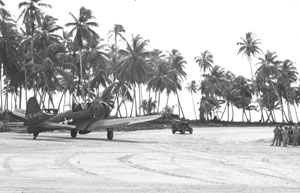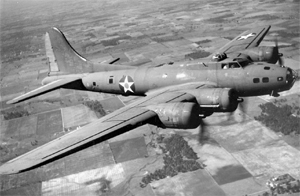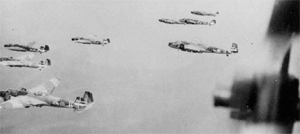Airplanes In My Novels

Mitsubishi A6M2 Zero
The Mitsubishi Zero took Allied air forces by complete surprise in December 1941 when it appeared in the skies over Pearl Harbor and Clark Field in the Philippines. Claire Chennault, operating with Chiang Kai Shek’s air force in China, sent an intelligence report on the Zero’s appearance and capabilities to the War Department, which discounted the report as so fantastical as to be unreliable.
The Zero was among the very first fighters of the war to have a combat radius of over 500 miles, enabling deep penetration missions. The Zero was powered by a 940-hp radial engine giving it a top speed around 330 mph. Armament consisted of two 7.7-mm machine guns mounted in the nose cowling and two 20-mm cannon in the wings.
This airplane appears in Everything We Had: a Novel of the Southwest Pacific Air War November-December 1941; A Snowball’s Chance: a Novel of the Pacific Air War January-February 1942; Boxcar Red Leader, a Novel of the Pacific Air War May 1942; and in Thanks for the Memories: a Novel of the SW Pacific Air War July-September 1942.
Photo credit: Imperial Japanese Navy via Wikimedia Commons (public domain).

Douglas A-20 “Boston”
The Douglas A-20 was a fast light attack bomber serving in the USAAF and a number of other air forces, including the RAF and RAAF, where it was known as the “Boston,” and also with the Free French and the Soviet air force. In the SW Pacific the A-20 was known for low-level attacks.
The A-20 was powered by two Wright R-2600 engines developing 1600 hp each, giving the airplane a top speed of 325 mph, with a range of 945 miles. Prior to the adoption of the dorsal turret in the “G” model, the A-20 was armed with up to six forward-firing .50-cal. guns and two .30-cal. guns on a rear-facing flexible mount. It could carry 4000 lbs. of bombs.
This airplane appears in Shoestring’s End: a Novel of the SW Pacific Air War December 1942 – March 1943.
Photo credit: USAF via Wikimedia Commons (public domain).

Lockheed P-38 “Lightning”
The Lockheed P-38 Lightning might have been the first truly multi-role tactical aircraft. It was an air-superiority fighter, photo recon, long range escort, night fighter, fighter bomber, and, over short ranges, could carry the same bomb load as a B-17. With a few breaks in its developmental history it might have eclipsed the far better-known P-51 Mustang. But, them’s the breaks, or the lack thereof.
The P-38 was powered by the Allison V-1710 engine producing 1600 hp with turbosupercharging, giving a maximum speed of 414 mph, with a combat radius of 650 miles. As a fighter it was armed with four .50-cal. machine guns and a 20-mm cannon, installed in the nose to give a tight, devastating cone of fire. In the fighter-bomber role it could carry anything from 2000-lb bombs to 5-in high-velocity aircraft rockets.
This airplane appears in Shoestring’s End: a Novel of the SW Pacific Air War December 1942 – March 1943.
Photo credit: USAF via Wikimedia Commons (public domain).

Douglas A-24 Banshee
The Douglas A-24 Banshee was the USAAF version of the Navy’s Douglas SBD Dauntless dive bomber. The 3rd Attack Group was originally equipped with A-24s, but the type proved unsuited to combat in the environment of Java and New Guinea, and after considerable losses was withdrawn from the combat role.
The A-24 was powered by a Wright R-1820 radial engine producing 1200 hp. The airplane had a top speed of 255 mph, carrying a 1000-lb bomb, over a range of 600 miles.
This airplane appears in A Snowball’s Chance: a Novel of the Pacific Air War January-February 1942.
Photo credit: USAF via Wikimedia Commons (public domain).

Boeing B-17D Flying Fortress
The Boeing B-17 Flying Fortress was the first four-engine heavy bomber adopted by the US Army Air Corps for regular use. The picture above depicts a B-17D known as “The Swoose,” having been rebuilt in Australia from parts from B-17C and B-17E aircraft. This type of improvisational repair was common in the SW Pacific theater, especially in the first two years of US involvement in World War II. The Smithsonian Air & Space Museum is restoring “The Swoose.”
This type B-17 appears in Everything We Had: a Novel of the Southwest Pacific Air War November-December 1941, and in A Snowball’s Chance: a Novel of the Pacific Air War January-February 1942.
Photo credit: USAF via Wikimedia Commons (public domain).

Martin B-26 Marauder
The Martin B-26 Marauder is a relatively fast medium bomber whose first use in combat during World War II was in the SW Pacific theater, operated by the 22nd Bomb Group. Eventually it was used not only in the SW Pacific but in Northern Europe and the Mediterranean, where it overcame its initial fearsome reputation as a pilot-killer.
The B-26 was powered by two P&W R-2800 engines developing 2000 hp each, enabling a top speed of 287 mph and a range of 1150 miles. The airplane carried a defensive armament of up to eleven .50-cal. machine guns, including four in fuselage blisters below and aft of the cockpit. Maximum bomb load was 4000 pounds.
This airplane appears in Boxcar Red Leader, a Novel of the Pacific Air War May 1942; and in Thanks for the Memories: a Novel of the SW Pacific Air War July-September 1942.
Photo credit: USAF via Wikimedia Commons (public domain).

Bell P-39 Airacobra
The P-39 Airacobra and the P-40 Warhawk were the fighters the USAAF had to fight with in 1941 and 1942. They remained numerically important, especially in theaters like the SW Pacific, through 1943.
The Airacobra was designed around a 37-mm cannon installation in the nose. This resulted in the unorthodox placement of the engine behind the pilot. The P-39D, the first version to see combat, was armed with the 37-mm cannon, two cowl-mounted .50-cal. machine guns, and two .30-cal. machine guns on each wing. The Airacobra was powered by an Allison V-1710 engine identical to that in the P-40, developing 1200 hp, with a top speed of 389 mph. The type had a combat radius of less than 300 miles.
This airplane appears in Boxcar Red Leader, a Novel of the Pacific Air War May 1942; and in Thanks for the Memories: a Novel of the SW Pacific Air War July-September 1942.
Photo credit: USAF via Wikimedia Commons (public domain).

Curtiss-Wright CW-21B “Demon”
Curtiss Wright designed the CW-21 expressly for the foreign export market as a bomber interceptor with an exceptionally high rate of climb. As supplied to the Dutch colonial forces in Indonesia, the Militaire Luchtvaart van het Koninklijk Nederlands-Indisch Leger (aka ML-KNIL), the type was powered by an 850-hp radial engine allowing it to achieve a top speed of 314 mph with a rate of climb of 4500 feet per minute. It was armed with two .30-cal. and two .50-cal. machine guns.
The type was used in combat during the Japanese invasion of Indonesia in January and February of 1942. However, it suffered from lightweight construction and cracking in sub-components, although ML-KNIL units equipped with the type claimed a handful of Japanese fighters.
This airplane appears in A Snowball’s Chance: a Novel of the Pacific Air War January-February 1942.
Photo credit: National Archives of the Netherlands via Wikimedia Commons (public domain).

Curtiss P-40 Warhawk
The Curtiss P-40 was adopted by the US Army Air Corps in April 1939. It was the first US fighter approaching the performance of foreign designs like the Hawker Hurricane and the Messerschmitt Bf-109. The P-40E had an Allison V-1710 engine rated, when the war began, at around 1150 hp, giving the P-40 a top speed of 362 mph.
The type was renowned for its firepower, relatively high diving speed, and ability to absorb punishment.
This airplane appears in Everything We Had: a Novel of the Southwest Pacific Air War November-December 1941, and in A Snowball’s Chance: a Novel of the Pacific Air War January-February 1942.
Photo credit: USAF via Wikimedia Commons (public domain).

Boeing B-17E Flying Fortress
The Boeing B-17E Flying Fortress represented a major redesign of the airplane, with the two most obvious changes being the ventral fillet on the vertical stabilizer, and the addition of powered gun turrets and a tail gun position. These changes lowered the top speed of the airplane slightly, from 323 mph in the B-17D to 287 mph in the “E”. The picture above is largely how a B-17E sent to the SW Pacific in 1942 would have looked.
The B-17E was powered by four Wright R-1820 radial engines of 1200 hp each. Top speed was, as noted above, 287 mph, with a range of 2000 miles. On long-range missions up to 4500 lbs. of bombs could be carried. Defensive armament was thirteen .50-cal. machine guns.
This airplane appears in This airplane appears in Everything We Had: a Novel of the Southwest Pacific Air War November-December 1941; A Snowball’s Chance: a Novel of the Pacific Air War January-February 1942; Boxcar Red Leader, a Novel of the Pacific Air War May 1942; Thanks for the Memories: a Novel of the SW Pacific Air War July-September 1942; and in Shoestring’s End: a Novel of the SW Pacific Air War December 1942 – March 1943.
Photo credit: USAF via Wikimedia Commons (public domain).

Lockheed Hudson
The Lockheed Hudson was a continuation of the Lockheed 10 family of twin-engined transports, the most famous example being the highly modified version flown by Amelia Earhart and Fred Noonan on their attempt to fly around the world in 1937. The basic design was amenable to modification as a light bomber, reconnaissance plane, and transport. Lockheed mostly built the Hudson for foreign air forces, notably the RAF, RCAF, RAAF, and RNZAF.
The Hudson was powered by two Wright R-1820 engines developing 1100 hp each, giving it a top speed of nearly 250 mph. Maximum range was 1960 miles. It carried four .303-cal. machine guns, two in nose mounts, and two in a dorsal turret. Bomb load was about 1400 lbs, which could be substituted for depth charges in the anti-submarine role.
This airplane appears in A Snowball’s Chance: a Novel of the Pacific Air War January-February 1942; Boxcar Red Leader, a Novel of the Pacific Air War May 1942; and in Thanks for the Memories: a Novel of the SW Pacific Air War July-September 1942.
Photo credit: Royal Canadian Air Force photo via Wikimedia Commons (public domain).

Boeing P-26 “Peashooter”
The Boeing P-26 was the first all-metal monoplane fighter, adopted in 1933 by what was then the US Army Air Corps. It had a 600-hp radial engine with a top speed of 234 mph. Armament was two .30-caliber machine guns. In December of 1941 it was obsolete, and was being replaced in front line service with the US Army Air Forces by the P-39 Airacobra and the P-40 Tomahawk.
This airplane appears in Everything We Had: a Novel of the Southwest Pacific Air War November-December 1941.
Photo credit: USAF via Wikimedia Commons (public domain).

Seversky P-35A
The Seversky P-35A was the first single-seat, all-metal, enclosed cockpit, retractable-gear monoplane fighter adopted by the US Army Air Corps. It was powered by a twin-row radial engine producing 1050 hp, giving the airplane a top speed of about 290 mph. Armament consisted of two .30-cal. and two .50-cal. machine guns.
The USAAF scraped the bottom of the barrel to reinforce the Philippines garrison in mid-to-late 1941, going so far as to requisition export versions of the P-35 ordered by the Swedish Air Force to send to the Philippines. Those airplanes had Swedish markings and flight and engine instruments marked in metric units.
This airplane appears in Everything We Had: a Novel of the Southwest Pacific Air War November-December 1941.
Photo credit: USAF via Wikimedia Commons (public domain).

Douglas A-20 “Boston”
The Douglas A-20 was a fast light attack bomber serving in the USAAF and a number of other air forces, including the RAF and RAAF, where it was known as the “Boston,” and also with the Free French and the Soviet air force. In the SW Pacific the A-20 was known for low-level attacks.
The A-20 was powered by two Wright R-2600 engines developing 1600 hp each, giving the airplane a top speed of 325 mph, with a range of 945 miles. Prior to the adoption of the dorsal turret in the “G” model, the A-20 was armed with up to six forward-firing .50-cal. guns and two .30-cal. guns on a rear-facing flexible mount. It could carry 4000 lbs. of bombs.
This airplane appears in Shoestring’s End: a Novel of the SW Pacific Air War December 1942 – March 1943.
Photo credit: USAF via Wikimedia Commons (public domain).

Douglas C-47 “Skytrain”
The Douglas C-47 “Skytrain,” also known to the Commonwealth Air Forces as the Dakota, was developed from the civilian DC-3 airliner. The prototype DC-1 first flew in July of 1933, not quite thirty years after the Wright Brothers first flight. The production models, first the DC-2, followed by the DC-3, were the first airliners that could carry a big enough load with enough economy of operation to turn a profit for the operator.
The C-47, in the hands of even a reasonably skilled pilot, could land and take off with a load on harrowingly short runways, or even level meadows. The phrase “Anywhere, Anytime” might not have originated with the C-47, but the airplane exemplified that motto. It pioneered modern ideas of combat airlift, and has served with airlines and air forces worldwide.
The C-47 was powered by two P&W R-1830 engines producing 1200 hp. It had a maximum speed of 230 mph and a maximum range of 1600 miles. It could carry up to 28 paratroopers or three tons of cargo, and could be configured as an ambulance plane equipped to handle 14 stretcher cases accompanied by three nurses.
This airplane appears in Thanks for the Memories: a Novel of the SW Pacific Air War July-September 1942, and in Shoestring’s End: a Novel of the SW Pacific Air War December 1942-March 1943.
Photo credit: USAF via Wikimedia Commons (public domain).

Boeing B-29 “Superfortress”
The B-29 Superfortress was at the outer limit of what aviation technology was capable of producing when the US Army Air Corps published a specification for a “superbomber” in December 1939. The specification required, among other things, that the new airplane be able to deliver a 20,000-lb bomb load to a target 2667 miles distant at a speed of 400 mph, a highly ambitious program to mount only thirty-six years after the Wright brothers staggered into the air at Kitty Hawk, NC. In the end, the total cost of producing nearly 4000 B-29 bombers would exceed that of the Manhattan Project that developed the atomic bomb.
The B-29 was driven by four Wright R-3350 radial engines producing 2200 hp each, giving a top speed of 357 mph and a range of 3250 miles. It carried eight or ten .50-cal. guns in remotely operated turrets. Bomb load was 12,000 lbs. over 1600 mile radius at medium altitude.
This airplane, or at least its prototype, appears in The New Kids: a Novel of the Air War on the Home Front, September 1942. Not its last appearance.
Photo credit: USAF via Wikimedia Commons (public domain).

Consolidated PBY Catalina
The PBY Catalina is a maritime patrol and reconnaissance seaplane developed initially for the US Navy in the mid-1930s. It was used extensively in those roles by RAF Coastal Command, the RAAF, and the RNZAF as well, and proved adaptable to service in nearly any weather or climate from the tropics to the arctic.
The Catalina was powered by two P&W R-1830 radial engines of 1200 hp each, giving a maximum speed of slightly less than 200 mph and a range of 2520 miles. Defensive armament consisted of two .50-cal. machine guns in the side blisters, one .30-cal. machine gun in a nose turret, and a .30-cal. machine gun firing from a hatch below the tail.
This airplane appears in Everything We Had: a Novel of the Southwest Pacific Air War November-December 1941; A Snowball’s Chance: a Novel of the Pacific Air War January-February 1942; Boxcar Red Leader, a Novel of the Pacific Air War May 1942; and in Thanks for the Memories: a Novel of the SW Pacific Air War July-September 1942.
Photo credit: US Navy via Wikimedia Commons (public domain).

Mitsubishi G3M “Nell”
The Mitsubishi G3M “Nell” was a medium bomber used by the Imperial Japanese Navy in the late 1930s and early 1940s. This airplane was designed to carry a heavy bomb load over long distances. Torpedo-armed bombers of this type and the newer Mitsubishi G4M “Betty” were responsible for sinking British warships HMS Repulse and HMS Prince of Wales off the Malay Peninsula on December 10, 1941.
The Nell was powered by two radial engines developing 1060 hp each. Maximum speed was around 230 mph, with a range of 2700 miles. Four 7.7-mm machine guns and a 20-mm cannon were carried as defensive armament. Bomb loads of up to 1800 pounds, or one aerial torpedo, were carried.
This airplane appears in A Snowball’s Chance: a Novel of the Pacific Air War January-February 1942, and in Boxcar Red Leader, a Novel of the Pacific Air War May 1942.
Photo credit: Imperial Japanese Navy via Wikimedia Commons (public domain).